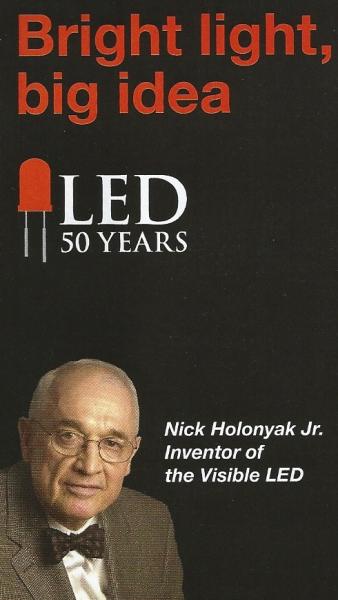Ever since UI professor Nick Holonyak created a light-emitting diode, the world’s been a brighter – and better – place
Illinois Alumni magazine September 2012
From headlights and traffic lights to DVD players, advanced medical equipment, and billboards, the light from LEDs is all around you. Nick Holonyak Jr. ’50 ENG, MS ’51 ENG, PHD ’54 ENG, the first graduate student of two-time Nobelist and University of Illinios professor John Bardeen, HON ’74 (who devised the transistor), did his remarkable teacher proud with another electronic breakthrough — the invention of the first practical visible-spectrum LED.Holonyak, who holds the John Bardeen Endowed Chair in Electrical and Computer Engineering and Physics, and teaches electrical and computer engineering at Illinois, is often credited with creating the field.
In honor of this world-changing invention and the man behind it, the University will honor Holonyak at an international symposium this October marking the 50th anniversary of the LED. , Jr., created the field by developing the first visible LED in 1962 (see sidebar).
“It’s like no other mechanism”
But what IS an LED (light-emitting diode), exactly? How does it work and what makes it so great?
A diode is a semiconductor, shaped like a chip or wafer, approximately the size of a grain of sand, through which electricity flows in one direction. When that happens, positively and negatively charged particles combine to produce light. The color of the light depends on the materials used to make the semiconductor; the first
visible LED of Holonyak’s was red.
The LED differs from any other artificial light source. With an LED, the electric current itself directly generates the light; conventional light sources use electrical current to excite an intermediary element (either a filament, such as in an incandescent bulb, or mercury vapor, for fluorescent bulbs.)
Conventional lighting is really generating heat, with light as a byproduct. Not so with the LED, whose light emissions are a primary process, not a secondary one.
“It’s like no other mechanism,” Holonyak says. “It is the ultimate lamp because it makes light energy right out of the electrical process.”
Color my world
While, in principle and on paper, the LED is the “ultimate lamp,” it has taken many decades of refinement to make it commercially viable beyond indicator lights (which were marketed almost immediately).
“Mine were the first LEDs that you could buy in 1962,” says Holonyak. “You wouldn’t like the price but you could buy ‘em.”
While over the years LEDs became brighter, more efficient, more affordable and suitable for exterior use (such as in automobile brake lights), creating colors other than red proved challenging.
Three such breakthroughs were made by Holonyak’s own students. Ten years after Holonyak made the inaugural LED, M. George Craford developed the first one that was yellow. His team at Hewlett-Packard created red and red-orange lights; his Monsanto group increased the brightness of the red LED tenfold. In the 1990s, Fred Kish at HP found ways to further brighten red, orange and yellow LEDs, a technique that also made LEDs much more cost-effective as replacements for red-filtered incandescent stop lights. Also at HP, Michale Krames, fashioned the chip shape to get even more light out.
In the 1990s, Japan’s Nichia Corporation introduced highly efficient, high-performance blue and green LEDs. Blue LEDs proved key because when combined with yellow phosphor, they could produce yet another color — white.
What’s not to like in an LED?
Because the LED is what Holonyak calls a “primary light source,” it is vastly efficient. Red LEDs can convert energy to colored light 10 times more efficiently than an incandescent bulb can. On top of that the life span of an LED — up to 100,000 hours or 10 years of use — is 100 times that of an incandescent.
In addition, LEDs produce significantly less heat, making them better suited for clock displays and medical instruments, and they don’t have a bulb that can break.
No matter the hue, LEDs are definitely “green.” Their smaller size means less material is entering the waste stream. Unlike compact fluorescent bulbs, they do not contain mercury gas, which is very difficult to safely dispose of. LEDs also draw less power and are four to five times more efficient than an incandescent light bulb. Their only drawback is the cost more.
None better
Vast arrays of applications lend themselves to LED use. You can “make it so Las Vegas can play games with fancy signs, or doctors can put one ion a catheter and look up into a person to see what’s wrong,” says Holonyak of his creation.
“You will not make, in principle, a better light source,” he claims.
Once he invented the first visible LED, Holonyak knew that lighting had changed forever. It doesn’t take much “for people to realize that all the usual lighting is going to get wiped out,” he says.
And yes, he’s pleased to see his “ultimate lamp” has taken center stage.



0 Comments